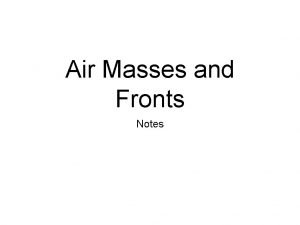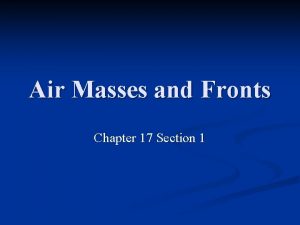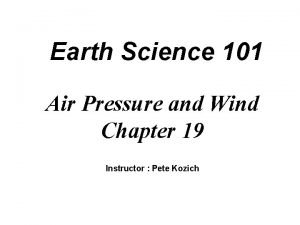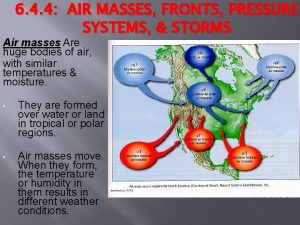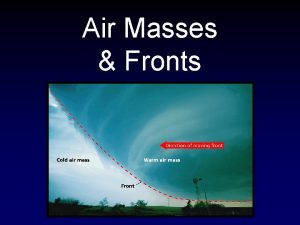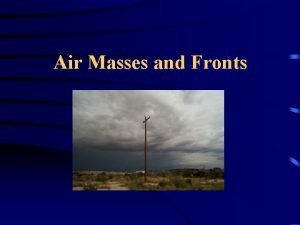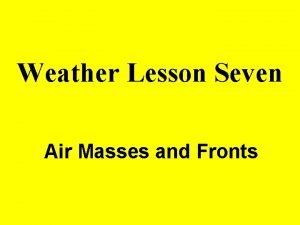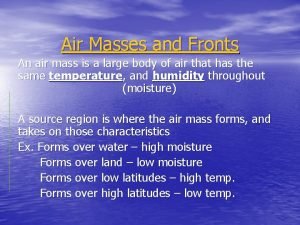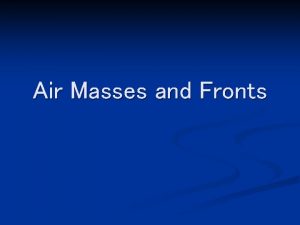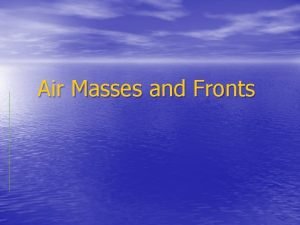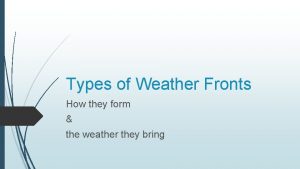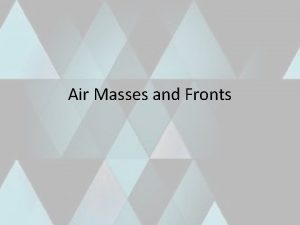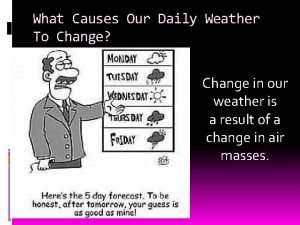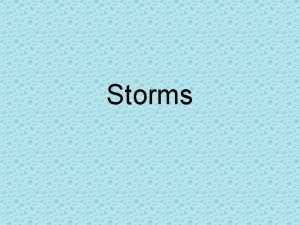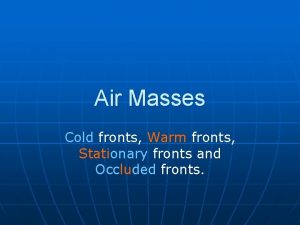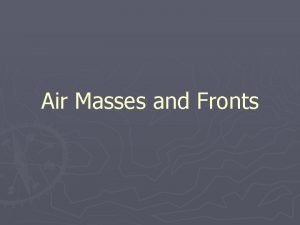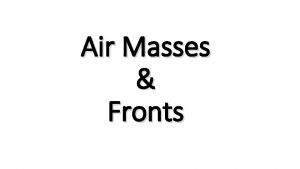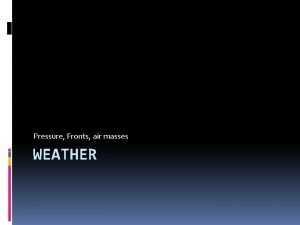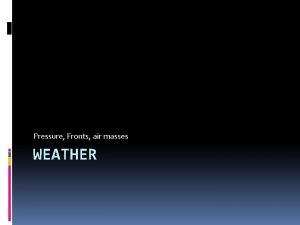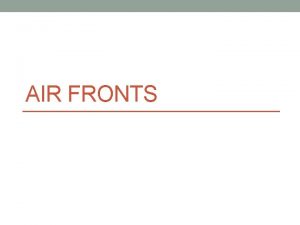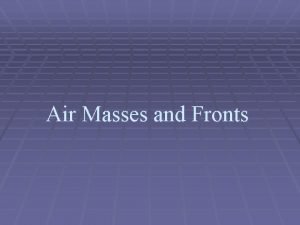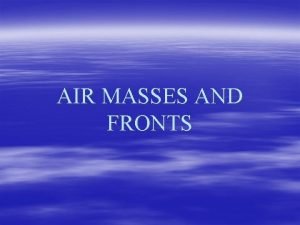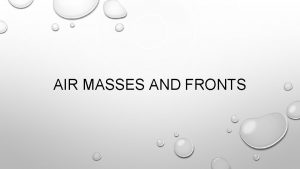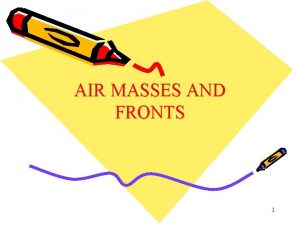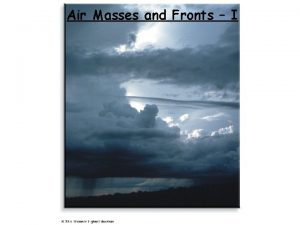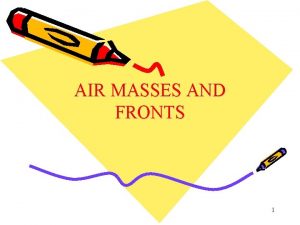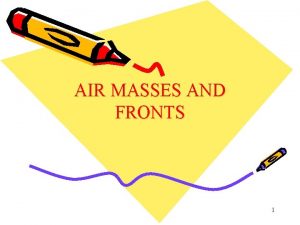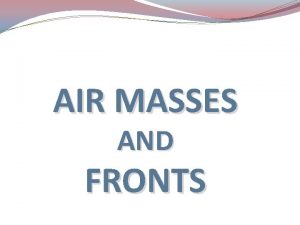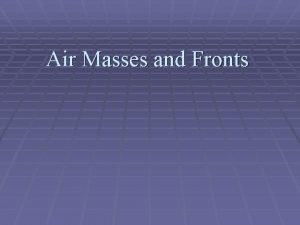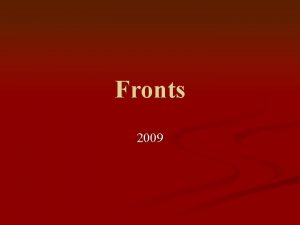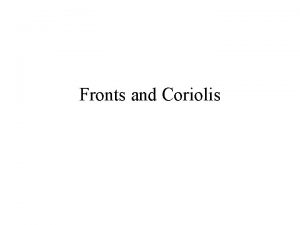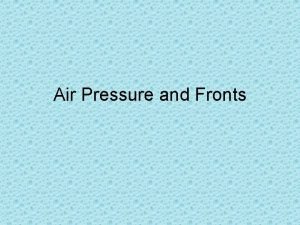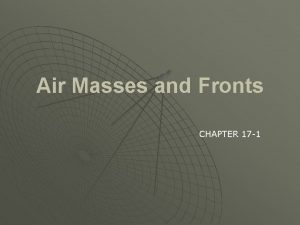AIR PRESSURE AIR MASSES AND FRONTS Earth Science
























- Slides: 24

AIR PRESSURE, AIR MASSES AND FRONTS Earth Science

Air Pressure � Air Pressure: The weight of the air pushing down on the surface of earth. Barometer: • The tool that measures air pressure.

High and Low Pressure Systems � High pressure is caused by Cool, Dry air SINKING. � Low pressure is caused by Warm, Moist air RISING. � Cool, Dry Air = High Pressure � = Clear Skies � � Warm, �= Moist Air Low Pressure �= Cloudy Skies

ISOTHERMS Isotherms: Lines connecting place of equal temperature

Pressure Centers � Isobars: Lines on a map connecting places with equal pressure. This shows you the area of High and Low Pressure. � Arrows show direction of wind.

DRAWING ISOBARS • 000 •

Global Winds � Global Winds: the global circulation of air from HIGH pressure to LOW pressure. � THE WINDS WILL BLOW FROM HIGH TO LOW � The winds would go either North or South except for the Coriolis Effect causes the wind to curve to the RIGHT � What Global Winds affect North America? Prevailing Westerlies

Coriolis Effect � The apparent curve of the wind to the right in the Northern Hemisphere. � Caused by Earth’s Rotation � http: //www. wiley. com/college/strahler/0471480533/animations/c h 07_animations/animation 2. html

Pressure Systems � Surface winds: � High = Move OUT of the center � Low = Move IN toward the center � Add the Coriolis effect (curve to the right) Motion around a High = Clockwise Motion around a Low = Counter Clockwise Anti. Cyclone

AIR MASSES � Air Mass: A large volume of air defined by its TEMPERATURE and WATER VAPOR. �c = Continental = Dry � m = Maritime = Moist � P = Polar = Cold � T = Tropical = Warm � c. P = Continental Polar air =Cold, Dry air from Canada � m. P = Maritime Polar air = Cold, Moist air from N. Atlantic Warm, Dry air from Mexico � c. T = Continental Tropical = � m. T = Maritime Tropical = Warm, Moist air from Gulf of Mexico

Frontal Boundaries � Frontal Boundary = Where two different air masses collide. � Cool, Dry air collides with Warm, Moist air.

Cold Front � Cold Front = Where a c. P air mass collides with a m. T air mass. � c. P air is doing the pushing. � m. T air is rising UP creating vertical clouds. � Cumulonimbus clouds � Thunderstorm What is the weather at A? � What is the weather at B? � What is the weather at C? � C B A

Warm Front � Warm Front = When a m. T air mass collides with a c. P air mass. � m. T air mass is doing the pushing. � As m. T air pushes, it rises over the c. P air creating low horizontal clouds. � Stratus, nimbostratus, cirrus What is the weather at A? � What is the weather at B? � What is the weather at C? � C B A

Weather Map Symbols � Identify the weather map symbols to determine weather in your area. � Cold Front = � Warm Front = c. P m. T

Weather Forecasting c. P NW m. T S W

Current U. S. Weather Map � May 24, 2011

Friday’s Weather Map m. P m. T

Mid-Latitude Cyclone

Hurricanes � 3 things needed to form a hurricane � Low Pressure � Warm ocean temperatures � High humidity

Hurricane � Where are hurricanes located when at their strongest? � Winds over 76 mph

Hurricanes � What happens when the hurricane hits land?

Weather Station Model � Used to deliver a lot of information in a small space

Weather Map

 Air masses and fronts
Air masses and fronts Types of air masses
Types of air masses Air masses and fronts
Air masses and fronts A swirling center of low air pressure is called
A swirling center of low air pressure is called Air mass source regions
Air mass source regions Area of low pressure where air masses meet and rise
Area of low pressure where air masses meet and rise Air masses form in the tropics and have low pressure
Air masses form in the tropics and have low pressure Mercury barometer
Mercury barometer Fronts and pressure systems
Fronts and pressure systems Two cold air masses converge on a warm air mass
Two cold air masses converge on a warm air mass Cold front air movement
Cold front air movement Air masses & frontswhat is an air mass?
Air masses & frontswhat is an air mass? The boundary between two adjacent air masses is called
The boundary between two adjacent air masses is called Air masses & frontswhat is an air mass?
Air masses & frontswhat is an air mass? Air masses & frontswhat is an air mass?
Air masses & frontswhat is an air mass? Stationary front
Stationary front Stationary front weather
Stationary front weather Air fronts
Air fronts Air masses and their characteristics
Air masses and their characteristics Modern earth science
Modern earth science What does a wind vane measure
What does a wind vane measure Source regions for air masses
Source regions for air masses Diagram of warm front
Diagram of warm front Large rotating air mass
Large rotating air mass Importance of air masses
Importance of air masses

